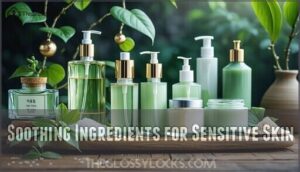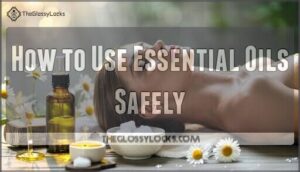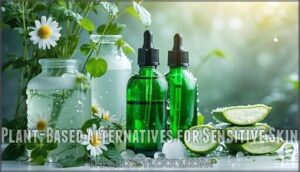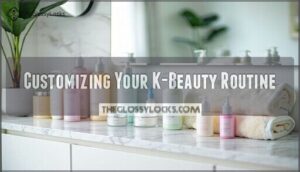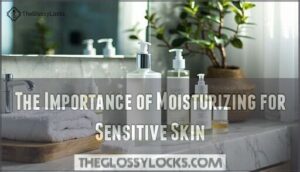This site is supported by our readers. We may earn a commission, at no cost to you, if you purchase through links.

Start with three essentials: a mild cleanser, hydrating toner, and barrier-repairing moisturizer. Look for ingredients like ceramides, hyaluronic acid, and centella asiatica while avoiding harsh acids and essential oils.
Introduce new products one at a time, allowing your skin to adjust before adding the next step. This methodical approach lets you enjoy K-beauty’s hydration benefits without triggering irritation.
The secret lies in understanding which specific ingredients can make or break your sensitive skin journey.
Table Of Contents
- Key Takeaways
- Sensitive Skin Considerations
- Simplifying The K-Beauty Routine
- Natural Extracts and Sensitive Skin
- Customizing Your K-Beauty Routine
- Maintaining a Healthy Skin Barrier
- Frequently Asked Questions (FAQs)
- What is the 4 2 4 rule in skincare?
- What is the best skin routine for sensitive skin?
- What is the Korean skincare 3 second rule?
- How to get Korean glass skin for sensitive skin?
- What are the key differences between morning and night routines?
- Can I use Korean skincare products during pregnancy or breastfeeding?
- How do I patch test new skincare products effectively?
- Are there any specific Korean skincare ingredients to avoid?
- Can pregnant women use Korean skincare products?
- How long before seeing sensitive skin improvements?
- Conclusion
Key Takeaways
- Start with just three products – You’ll need a gentle cleanser, a hydrating toner, and a barrier-repairing moisturizer to avoid overwhelming your sensitive skin with complex routines.
- Choose fragrance-free formulations – You’ll prevent irritation by selecting products with ceramides, hyaluronic acid, and centella asiatica, while avoiding harsh acids and essential oils.
- Introduce products gradually – You’ll protect your skin barrier by adding one new product at a time and allowing adjustment periods between additions.
- Focus on consistency over complexity – You’ll see better results with a simple routine you can maintain daily, rather than attempting elaborate multi-step processes that may trigger reactions.
Sensitive Skin Considerations
When you have sensitive skin, identifying your unique triggers becomes your first line of defense against irritation and flare-ups.
Your skin’s reactions can stem from sun exposure, weather changes, harsh ingredients, or even over-exfoliation that damages your protective barrier.
Identifying Sensitive Skin Triggers
Understanding your sensitive skin triggers often feels like solving a puzzle, but you’re the detective who can crack the case. Your skin reacts to specific culprits that cause redness, irritation, and discomfort, making it essential to identify these troublemakers.
Your sensitive skin is like a detective story—you hold all the clues to solve the mystery of what triggers your reactions.
Common allergens like pollen, pet dander, and certain foods can trigger allergic reactions that show up as skin irritation. It’s your skin’s way of saying it’s not happy with these substances.
Lifestyle choices substantially impact your sensitive skin. Stress impact from daily pressures, lack of sleep, and even that evening glass of wine can appear as flare-ups on your face.
Environmental factors act like external villains attacking your skin barrier. Pollution, sun exposure, and temperature extremes create the perfect storm for irritation.
By tracking these triggers through ingredient sensitivity patterns, you’ll develop a roadmap to calmer, healthier skin. Remember to choose fragrance-free products whenever possible to minimize potential reactions.
Common Irritants in K-Beauty Products
Now that you’ve spotted the signs of sensitive skin, let’s explore what ingredients might be causing trouble.
Fragrances top the list as the leading cause of contact dermatitis – they’re sneaky troublemakers hiding in many K-beauty products. Essential oils like lavender sound natural and harmless, but they can trigger reactions just as easily.
Harsh actives such as high-concentration vitamin C or chemical exfoliators can overwhelm delicate skin. Alcohol content strips away natural oils, while synthetic dyes and preservatives like parabens add unnecessary irritation risks.
To mitigate these issues, natural ingredients offer gentleness and nourishment.
Irritant Why it’s a problem What to look for instead
Alcoholfree gentle cleansers
Patch Testing for Sensitive Skin
Patch testing serves as your safety net against allergic outbreaks.
Test new products on your inner wrist every 2-3 days, watching for mild irritation like redness or stinging.
This allergy identification process prevents full-face disasters.
Create a simple tracking system with labels and dates.
Gradual introduction works best—if you react, note problematic ingredients for future product introduction decisions.
Building a Gentle Skincare Foundation
After patch testing confirms product safety, you’re ready to build your gentle skincare foundation. Start with a minimalist approach using just four core products. Choose a gentle cleanser that respects your skin’s natural barrier while effectively removing impurities. Focus on hydration and barrier support rather than aggressive treatments.
- Gentle Cleansing: Select low-pH cleansers that won’t strip your skin’s protective oils
- Hydration Focus: Layer a hydrating toner to prep skin for better product absorption
- Barrier Support: Use a soothing serum with ingredients like centella or hyaluronic acid
- Minimalist Approach: Keep your sensitive skin routine simple with a calming moisturizer as your final step
Simplifying The K-Beauty Routine
K-beauty routines can feel overwhelming with their many steps, but you don’t need a 10-step routine to achieve healthy, glowing skin.
Start with the essential basics and build slowly to avoid irritating your sensitive skin.
Streamlining Your Skincare Steps
Simplicity becomes your ally when sensitive skin demands gentle care. Korean skincare’s multi-step approach doesn’t mean complexity—it means strategic product prioritization and ingredient focus.
- Start with routine minimalism: Begin with just cleanser, moisturizer, and sunscreen before adding layers
- Choose multi-tasking products: Select a gentle cleanser that hydrates while removing impurities
- Practice simplified layering: Apply thinnest to thickest consistency, allowing absorption between steps
- Create quick routines: Develop 5-minute morning and evening sequences for busy days
- Use soothing serum strategically: Apply your calming moisturizer over targeted treatments for maximum benefit
Essential Products for Sensitive Skin
Five essential products form your Korean skincare foundation for sensitive skin success.
Gentle Cleansers like Etude House SoonJung pH 6.5 Whip Cleanser maintain your skin barrier without stripping moisture.
Hydrating Toners with heartleaf extract prep your skin for better product absorption.
Lightweight Serums containing hyaluronic acid deliver deep hydration without overwhelming sensitive complexions.
Fragrance-Free Moisturizers such as Illiyoon Ceramide Ato Concentrate Cream provide lasting comfort and redness relief.
Finally, Mineral Sunscreens with zinc oxide offer gentle protection that won’t trigger irritation reduction concerns.
Many Korean sunscreens also feature skin-soothing ingredients ideal for sensitive skin.
Product Key Ingredients Benefits
How to Layer Products for Maximum Benefit
With your essential products ready, proper layering order maximizes their effectiveness.
Apply thinnest to thickest: essence first, then serum, followed by moisturizer. This layering order respects absorption rates and prevents ingredient conflicts.
Pat each product gently into damp skin—this boosts hydration and creates ideal product synergy for your sensitive skin barrier.
**Your Korean skincare routine optimization brings:
- Confidence knowing each layer works harmoniously with your skin
- Relief from guesswork about what goes when
- Peace of mind that you’re protecting your delicate skin barrier
- Joy in watching your skin transform with consistent, gentle care
Avoiding Over-Exfoliation and Irritation
After properly layering your korean skincare products, you’ll want to protect that progress by avoiding over-exfoliation and irritation. Sensitive skin requires a gentler approach to prevent barrier damage and maintain redness reduction.
Don’t overdo it! Here’s how to keep your skin happy:
- Limit exfoliation frequency: Stick to once weekly, maximum twice for resilient skin types.
- Choose chemical exfoliants: Gentle AHA/BHA formulas work better than harsh scrubs for sensitive skin.
- Focus on soothing ingredients: Look for centella, aloe, and niacinamide to support skin barrier repair after exfoliation.
To further avoid irritation, consider using pH-balanced cleansers to maintain the skin’s natural barrier.
Natural Extracts and Sensitive Skin
You might think natural equals gentle, but that’s not always true for sensitive skin.
While Korean skincare harnesses powerful plant extracts like centella and heartleaf, some natural ingredients can actually trigger irritation if you’re not careful.
Potential Pitfalls of Natural Ingredients
Despite their wholesome reputation, natural ingredients can backfire on sensitive skin.
Over 90% contain allergens that trigger contact dermatitis, while irritation from essential oils creates lasting rashes.
Inconsistent efficacy and formulation challenges make natural ingredients unpredictable for kbeauty sensitive skin routines.
| Natural Ingredient | Common Risk | Sensitivity Impact |
|---|---|---|
| Essential oils | Contact dermatitis | Redness, burning, peeling |
| Citrus extracts | Photosensitivity | Increased sunburn risk |
| Fragrances | Allergic reactions | Itchy, painful rashes |
| Plant extracts | Allergen risks | Weeks-long inflammation |
| Witch hazel | Drying effects | Overuse dangers worsen skin sensitivity |
Soothing Ingredients for Sensitive Skin
When your sensitive skin craves comfort, Centella Asiatica delivers cica benefits through powerful anti-inflammatory properties.
These calming ingredients work wonders for kbeauty sensitive skin routines:
- Heartleaf hydration – reduces redness while deeply moisturizing
- Aloe versatility – provides instant cooling and soothing relief
- Snail repair – accelerates healing with propolis protection
These gentle soothing heroes calm irritated skin naturally; colloidal oatmeal offers additional skin barrier support.
How to Use Essential Oils Safely
Using essential oils in your Korean skincare routine requires careful attention to dilution guidelines and patch testing.
Never apply oils directly to skin – dilute to 1% concentration with carrier oils like jojoba for sensitive skin.
Always patch test on your inner arm first and wait 24-48 hours for reactions.
Be mindful of photosensitivity risks with citrus oils, which can cause burns in sunlight.
For safe diffusion, start with small amounts to avoid irritation while maintaining your calming, fragrancefree products routine.
Plant-Based Alternatives for Sensitive Skin
Now that you’ve learned about safe essential oil use, let’s explore gentler botanical soothers for your korean skincare routine.
These vegan skincare alternatives won’t trigger your sensitive skin:
- Centella Asiatica – This green active reduces inflammation and provides natural hydration without irritation
- Chamomile extract – Calming ingredients like this offer herbal remedies for redness and sensitivity
- Aloe vera gel – Botanical extracts don’t get gentler than this soothing, healing powerhouse
Customizing Your K-Beauty Routine
You can customize your K-beauty routine to fit your sensitive skin’s unique needs by adjusting product choices and timing for different situations.
The key is creating morning and nighttime routines that adapt to seasonal changes while incorporating gentle treatments like face masks when your skin can handle them.
Creating a Morning Skincare Routine
Your morning routine builds the foundation for healthy, comfortable skin all day long. Start with gentle cleansing using a low-pH cleanser to remove overnight buildup without stripping your skin barrier.
Follow with lightweight layers of hydrating toner and soothing serum for a hydration boost. A suitable option is available for sensitive skin.
Korean skincare emphasizes routine consistency, so apply sunscreen application as your final step to protect sensitive skin from UV damage.
| Step | Product Type | Key Benefit |
|---|---|---|
| 1 | Gentle Cleanser | Removes impurities without irritation |
| 2 | Hydrating Toner | Prepares skin for better absorption |
| 3 | Soothing Serum | Calms and nourishes sensitive areas |
| 4 | Moisturizer | Locks in hydration and strengthens barrier |
| 5 | Sunscreen | Shields from environmental damage |
The key to effective skincare is to protect sensitive skin and maintain a consistent routine, ensuring that each step, from cleansing to applying sunscreen, contributes to the overall health and comfort of your skin.
Building a Nighttime Skincare Routine
Creating your nighttime Korean skincare routine becomes your skin’s favorite part of the day. Think of it as tucking your sensitive skin into bed with all the love it deserves. Your evening ritual focuses on repair and overnight hydration while you sleep.
Double Cleanse: Remove makeup and sunscreen with a gentle oil cleanser, then follow with a soothing foam cleanser for sensitive skin.
Targeted Treatments: Apply repair actives like niacinamide or centella to address specific concerns without irritation.
Hydrating Serum: Pat on a calming serum to boost your skin barrier overnight.
Nighttime Mask: Use gentle overnight masks 2-3 times weekly for extra nourishment.
Moisturize: Seal everything with a rich, fragrance-free moisturizer.
Routine consistency matters more than perfection. Discover korean skincare products for your nightly routine. Your skin repairs itself during sleep quality hours, so nighttime cleansing and proper hydration create the perfect environment for renewal.
Adjusting Your Routine for Different Seasons
Your nighttime routine works year-round, but seasonal ingredients and routine swaps help sensitive skin adapt to temperature changes and humidity effects.
Weather shifts trigger different sunscreen needs and soothing requirements for managing redness.
Winter: Switch to ceramide-rich moisturizers and cream cleansers to combat dry air that strips your skin’s natural barrier.
Summer: Use lightweight, oil-free products with niacinamide to handle increased humidity and prevent breakouts from sweat buildup.
Transition periods: Gradually introduce seasonal ingredients like antioxidants in fall to avoid shocking your already-sensitive skin with sudden changes.
Incorporating Face Masks for Sensitive Skin
Face masks can be your skin’s best friend when chosen wisely.
Start with soothing sheet masks containing gentle mask ingredients like aloe vera or centella asiatica for sensitive skin.
Use sheet masking 1-2 times weekly, while clay masks should be monthly treats.
DIY masks using oat or green tea work wonderfully.
Masks with ingredients like hyaluronic acid hydrate without irritation.
Proper mask frequency prevents irritation and redness in your korean skincare routine.
Maintaining a Healthy Skin Barrier
Your skin’s protective barrier works like a fortress wall, keeping irritants out and moisture locked in.
When this barrier becomes compromised, sensitive skin flares up with redness, dryness, and increased reactivity to products you’ve used without problems before.
The Importance of Moisturizing for Sensitive Skin
After customizing your Korean skincare routine, moisturizing becomes your skin’s best friend.
Your sensitive skin craves proper hydration levels and barrier function support to stay comfortable and healthy.
Korean skincare emphasizes gentle moisturization techniques that protect without overwhelming delicate skin.
- Boosts hydration levels – Keeps your skin plump and reduces that tight, uncomfortable feeling
- Strengthens barrier function – Creates a protective shield against environmental irritants and allergens
- Enhances ingredient safety – Helps previous skincare products absorb better while preventing irritation
How to Choose a Gentle Cleanser
Your cleanser choice can make or break your sensitive skin routine. Look for fragrance-free, low-pH cleansers with short ingredient lists—they’re gentler on your skin barrier.
Non-foaming formulas work best since they won’t strip natural oils. Always patch test new products on your inner wrist first.
Korean skincare brands excel at creating non-irritating cleansers that respect your skin type while effectively removing impurities.
Protecting Your Skin From Environmental Stressors
Everyone faces environmental stressors that can trigger sensitive skin reactions and compromise your skin barrier protection.
Your daily routine should include UV Protection through broad-spectrum sunscreen, Pollution Defense with antioxidant-rich serums, and Barrier Strengthening moisturizers.
Take into account these protective strategies:
- Apply mineral sunscreen containing zinc oxide to prevent UV damage and redness
- Use antioxidant serums with vitamin C or niacinamide for Pollution Defense against free radicals
- Maintain Hydration Balance with ceramide-enriched products to strengthen your irritated skin’s natural defenses.
It’s also important to think about weekly exfoliation benefits for cell regeneration.
Nourishing Your Skin With a Balanced Diet
Why not fuel your Korean skincare routine from within? Your gut-skin connection plays a vital role in managing sensitive skin and preventing redness.
Essential nutrients from antioxidant foods like berries and leafy greens combat inflammation while supporting skin barrier protection. Hydration importance can’t be overstated—water helps flush toxins that trigger sensitivity.
Food Group Benefits Examples
Avoid inflammatory foods like processed sugar and excess salt—they’ll sabotage your gentle skincare efforts.
Frequently Asked Questions (FAQs)
What is the 4 2 4 rule in skincare?
The 4-2-4 rule involves cleansing your face for four minutes, then applying a gentle toner for two minutes, followed by a four-minute moisturizing massage for deep hydration.
What is the best skin routine for sensitive skin?
Like a fragile flower needing gentle care, your sensitive skin requires a minimalist approach.
Start with gentle cleansing, use hydrating toners, apply lightweight serums, moisturize with fragrance-free formulas, and protect with mineral sunscreen daily.
What is the Korean skincare 3 second rule?
You’ll apply toner or essence to your face within three seconds of cleansing to lock in moisture and prevent dehydration, maximizing product absorption for healthier skin.
How to get Korean glass skin for sensitive skin?
Want glass skin but worried about sensitivity? You’ll need gentle hydration layers, not harsh actives. Start with lightweight toners, soothing serums like centella, and consistent sunscreen protection daily.
What are the key differences between morning and night routines?
Your morning routine focuses on protection with lightweight layers, gentle cleansing, and sunscreen. Your evening routine emphasizes repair with deeper cleansing, treatment serums, and heavier moisturizers for overnight healing.
Can I use Korean skincare products during pregnancy or breastfeeding?
Most Korean skincare products are pregnancy-safe, but you’ll want to avoid retinoids, salicylic acid, and hydroquinone.
Stick with gentle, fragrance-free formulas containing centella asiatica, hyaluronic acid, and snail mucin for maximum safety during this special time.
How do I patch test new skincare products effectively?
Testing’s absolutely essential – it’s your skin’s lifeline! Apply a tiny amount behind your ear, wait 24-48 hours, and watch for redness, itching, or irritation before using anywhere else.
Are there any specific Korean skincare ingredients to avoid?
Avoid fragrances, essential oils, and harsh actives like strong vitamin C formulations that can trigger irritation. These ingredients commonly cause redness, stinging, and allergic reactions in sensitive skin types.
Can pregnant women use Korean skincare products?
Looking to stay safe during pregnancy while maintaining healthy skin?
Most Korean skincare products are pregnancy-safe, but you’ll want to avoid retinoids, high-dose salicylic acid, and hydroquinone.
Always check ingredients and consult your doctor first.
How long before seeing sensitive skin improvements?
You’ll typically notice improvements in your sensitive skin within 2-4 weeks of consistent Korean skincare routine use, though some redness and irritation may calm down within days.
Conclusion
Building patience, maintaining consistency, and embracing simplicity will transform your korean skin care routine for sensitive skin into a sustainable practice.
You’ll discover that less truly becomes more when you focus on gentle, proven ingredients rather than trendy additions.
Your skin barrier will strengthen gradually as you stick to this mindful approach. Remember, sensitive skin requires time and patience—but the results are worth the careful journey toward healthier, calmer skin.
- https://thesecretlifeofskin.com/2022/03/17/korean-skincare/
- https://www.skinlabmedspa.com/all/others/why-is-korean-skincare-so-good-for-sensitive-skin/
- https://koreanskincare.co.uk/blogs/skintalks/3-step-sensitive-skin-care-routine
- https://www.reddit.com/r/KoreanBeauty/comments/1c1la6h/looking_for_skincare_that_fits_for_my_sensitive/
- https://sokoglam.com/pages/the-korean-skin-care-routine



